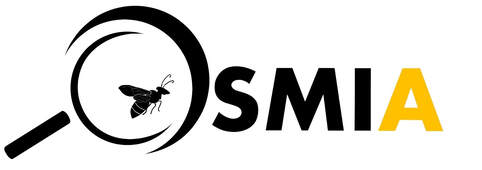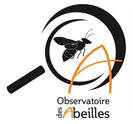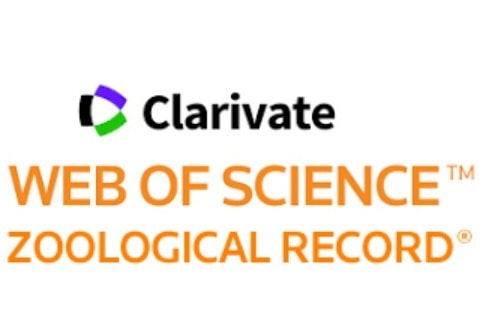Revue d'Hyménoptérologie
Journal of Hymenopterology
ISSN 2727-3806
ARTICLE |
Surviving the winter: Tetramorium sibiricum n. sp., a new Central Siberian ant species (Hymenoptera: Formicidae)
|
Bernhard Seifert
|
Citation
Seifert, B. (2021). Surviving the winter: Tetramorium sibiricum n. sp., a new Central Siberian ant species (Hymenoptera: Formicidae). Osmia, 9: 15–24. https://doi.org/10.47446/OSMIA9.3
Received 02 March 2021 - Accepted 26 April 2021 - Published (online) 29 April 2021
Indexation • Archivage - Archiving
Abstract
A new species of the thermophilous Tetramorium caespitum species complex, T. sibiricum n. sp., is described from the Central Siberian region near Ulan Ude that has mean January temperatures of – 24 °C. The new species is clearly separable from the related species, T. indocile Santschi, 1927 and T. caespitum (Linnaeus, 1758), by exploratory data analyses of 35 phenotypic characters and by a discriminant analysis of seven phenotypic characters. A key to these three species, which all might occur in Central Siberia, is provided. The zoogeographic divide called the Reinig Line (De Lattin, 1967) is considered to be important in separating the ranges of Central and East Palaearctic ant species with less strong cold-hardiness. Based on images of type specimens, Tetramorium annectens Pisarski, 1969 is recognized as heterospecific from T. tsushimae Emery, 1925.
Keywords
cryptic species, cold-hardiness, zoogeographic divide, numeric morphology-based alpha-taxonomy, Tetramorium caespitum species complex
Titre (traduction)
Survivre en hiver : Tetramorium sibiricum n. sp., une nouvelle espèce de fourmi centro-sibérienne (Hymenoptera : Formicidae)
Résumé
Une nouvelle espèce de fourmi appartenant au complexe d’espèces thermophiles Tetramorium caespitum, T. sibiricum n. sp., est décrite de Sibérie centrale, dans la région proche de Ulan Ude qui présente des températures moyennes en janvier de – 24 °C. Cette espèce est clairement différentiable des espèces apparentées, T. indocile Santschi, 1927 et T. caespitum (Linnaeus, 1758), par l’analyse exploratoire de données de 35 caractères phénotypiques et par l’analyse discriminante de sept caractères phénotypiques. Une clef dichotomique pour identifier ces trois espèces, qui peuvent être toutes trois présentes en Sibérie Centrale, est proposée. Une division zoogéographique appelée la Ligne de Reinig (De Lattin, 1967) est considérée comme importante pour séparer les aires de répartition des espèces de fourmis moins résistantes au froid des zones Centrale et Est Paléarctique. À travers l’analyse d’images de spécimens types, Tetramorium annectens Pisarski, 1969 est reconnue comme étant hétérospécifique à T. tsushimae Emery, 1925.
Mots-clefs
espèces cryptiques, résistance au froid, division zoogéographique, taxonomie alpha par analyse morphologique numérique, groupe d’espèces Tetramorium caespitum
References - Références
Seifert, B. (2021). Surviving the winter: Tetramorium sibiricum n. sp., a new Central Siberian ant species (Hymenoptera: Formicidae). Osmia, 9: 15–24. https://doi.org/10.47446/OSMIA9.3
Received 02 March 2021 - Accepted 26 April 2021 - Published (online) 29 April 2021
Indexation • Archivage - Archiving
- DOI: https://doi.org/10.47446/OSMIA9.3
- Zoobank (ICZN): http://zoobank.org/D029128F-2296-4AF4-A7F2-4BC9392202F6
- HAL (CNRS-INRAE): https://hal.archives-ouvertes.fr/hal-03212151
- Zenodo (CERN): https://zenodo.org/record/4727382
Abstract
A new species of the thermophilous Tetramorium caespitum species complex, T. sibiricum n. sp., is described from the Central Siberian region near Ulan Ude that has mean January temperatures of – 24 °C. The new species is clearly separable from the related species, T. indocile Santschi, 1927 and T. caespitum (Linnaeus, 1758), by exploratory data analyses of 35 phenotypic characters and by a discriminant analysis of seven phenotypic characters. A key to these three species, which all might occur in Central Siberia, is provided. The zoogeographic divide called the Reinig Line (De Lattin, 1967) is considered to be important in separating the ranges of Central and East Palaearctic ant species with less strong cold-hardiness. Based on images of type specimens, Tetramorium annectens Pisarski, 1969 is recognized as heterospecific from T. tsushimae Emery, 1925.
Keywords
cryptic species, cold-hardiness, zoogeographic divide, numeric morphology-based alpha-taxonomy, Tetramorium caespitum species complex
Titre (traduction)
Survivre en hiver : Tetramorium sibiricum n. sp., une nouvelle espèce de fourmi centro-sibérienne (Hymenoptera : Formicidae)
Résumé
Une nouvelle espèce de fourmi appartenant au complexe d’espèces thermophiles Tetramorium caespitum, T. sibiricum n. sp., est décrite de Sibérie centrale, dans la région proche de Ulan Ude qui présente des températures moyennes en janvier de – 24 °C. Cette espèce est clairement différentiable des espèces apparentées, T. indocile Santschi, 1927 et T. caespitum (Linnaeus, 1758), par l’analyse exploratoire de données de 35 caractères phénotypiques et par l’analyse discriminante de sept caractères phénotypiques. Une clef dichotomique pour identifier ces trois espèces, qui peuvent être toutes trois présentes en Sibérie Centrale, est proposée. Une division zoogéographique appelée la Ligne de Reinig (De Lattin, 1967) est considérée comme importante pour séparer les aires de répartition des espèces de fourmis moins résistantes au froid des zones Centrale et Est Paléarctique. À travers l’analyse d’images de spécimens types, Tetramorium annectens Pisarski, 1969 est reconnue comme étant hétérospécifique à T. tsushimae Emery, 1925.
Mots-clefs
espèces cryptiques, résistance au froid, division zoogéographique, taxonomie alpha par analyse morphologique numérique, groupe d’espèces Tetramorium caespitum
References - Références
- Bolton, B. (1995). A new general catalogue of the ants of the world. Harvard University Press, Cambridge & London, 504 pp.
- Csősz, S. & B. L. Fisher (2015). Diagnostic survey of Malagasy Nesomyrmex species-groups and revision of hafahafa group species via morphology based cluster delimitation protocol. ZooKeys, 526: 19–59. https://doi.org/10.3897/zookeys.526.6037
- De Lattin, G. (1967). Grundriss der Zoogeographie. Fischer, Jena (Germany), 602 pp.
- Dlussky, G. M. (1967). Murav'i roda Formica. Izdatel'stvo “Nauka”, Moscow, 216 pp.
- Francœur, A. (1983). The ant fauna near the tree-line in Northern Quebec (Formicidae, Hymenoptera). Nordicana, 47: 177–180. https://www.antwiki.org/wiki/images/1/14/Francoeur_1983.pdf [accessed 15 February 2021]
- Radchenko, A. G. (1992). Murav'i roda Tetramorium (Hymenoptera, Formicidae) fauny SSSR. Soobshchenie 2. Zoologichesky Zhurnal, 71(8): 50-58. https://antcat.org/references/127950 [accessed 15 February 2021]
- Ruzsky, M. (1925). Material po faune kurorta "Karachinskoe Ozero". Izvestiya Tomskogo Gosudarstvennogo Universiteta, 75: 283–290. https://antcat.org/references/128193 [accessed 15 February 2021]
- Seifert, B. (2000). A taxonomic revision of the ant subgenus Coptoformica Mueller, 1923. Zoosystema, 22(3): 517–568. https://sciencepress.mnhn.fr/fr/periodiques/zoosystema/22/3/revision-taxonomique-des-fourmis-du-sous-genre-coptoformica-mueller-1923-hymenoptera-formicidae [accessed 15 February 2021]
- Seifert, B. (2008). Removal of allometric variance improves species separation in multi-character discriminant functions when species are strongly allometric and exposes diagnostic characters. Myrmecological News, 11: 91–105. https://myrmecologicalnews.org/cms/index.php?option=com_content&view=category&id=247&Itemid=355 [accessed 15 February 2021]
- Seifert, B. (2018). The Ants of Central and North Europe. Lutra Verlags- und Vertriebsgesellschaft, Tauer (Germany), 408 pp.
- Seifert, B. (2020). Revision of the Plagiolepis schmitzii group with description of Pl. invadens sp. nov. – a new invasive supercolonial species (Hymenoptera: Formicidae). Deutsche Entomologische Zeitschrift, 67(2): 183–196. https://doi.org/10.3897/dez.67.53199
- Seifert, B. (2021). A taxonomic revision of the Palaearctic members of the Formica rufa group (Hymenoptera, Formicidae) – the famous mound-building red wood ants. Myrmecological News, 31: 133–179. https://doi.org/10.25849/myrmecol.news_031:133
- Seifert, B., M. Ritz & S. Csősz (2013). Application of Exploratory Data Analyses opens a new perspective in morphology-based alpha-taxonomy of eusocial organisms. Myrmecological News, 19: 1–15. https://myrmecologicalnews.org/cms/index.php?option=com_content&view=category&id=574&Itemid=363 [accessed 15 February 2021]
- Steiner, F.M., B. Seifert, K. Moder & B. Schlick-Steiner (2010). A multisource solution for a complex problem in biodiversity research: Description of the cryptic ant species Tetramorium alpestre sp.n. (Hymenoptera: Formicidae). Zoologischer Anzeiger, 249(3–4): 223–254. https://doi.org/10.1016/j.jcz.2010.09.003
- Wagner, H., W. Arthofer, B. Seifert, C. Muster, F. M. Steiner & B. C. Schlick-Steiner (2017). Light at the end of the tunnel: Integrative taxonomy delimits cryptic species in the Tetramorium caespitum complex (Hymenoptera, Formicidae). Myrmecological News, 25: 95–129. https://doi.org/10.25849/myrmecol.news_025:095
- Wang, M., Xiao, G. & J. Wu (1988). Taxonomic studies on the genus Tetramorium Mayr in China (Hymenoptera, Formicidae). [In Chinese]. Forest Research, 1: 264–274. https://doi.org/10.5281/zenodo.24951
- Wheeler, W.M. (1927). Chinese ants collected by Professor S. F. Light and Professor N. Gist Gee. American Museum Novitates, 255: 1–12. http://hdl.handle.net/2246/4193










